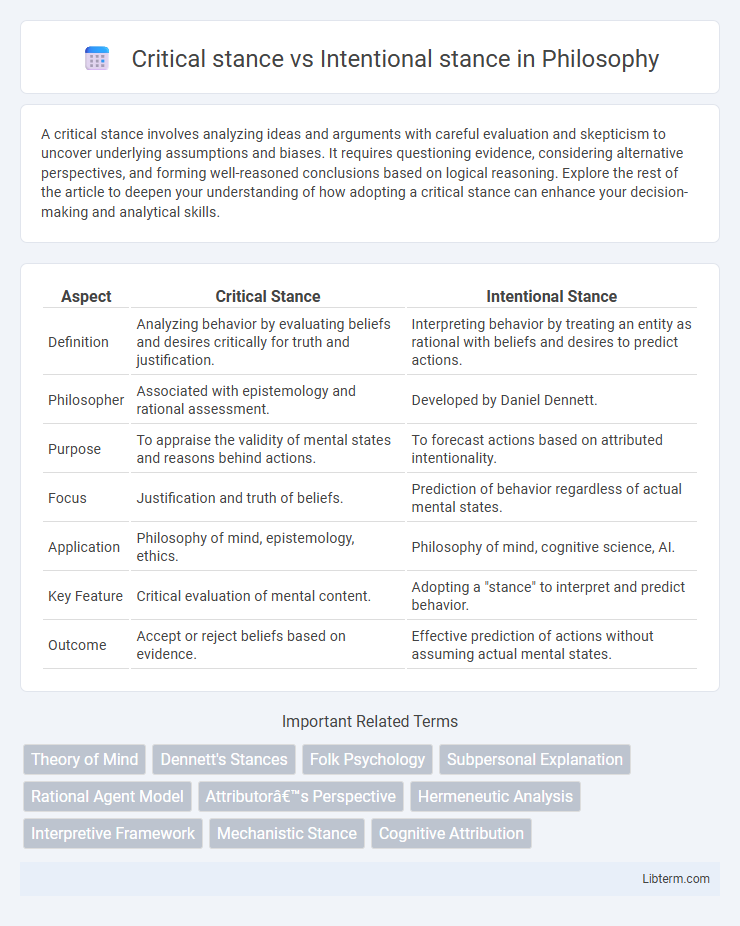A critical stance involves analyzing ideas and arguments with careful evaluation and skepticism to uncover underlying assumptions and biases. It requires questioning evidence, considering alternative perspectives, and forming well-reasoned conclusions based on logical reasoning. Explore the rest of the article to deepen your understanding of how adopting a critical stance can enhance your decision-making and analytical skills.
Table of Comparison
| Aspect | Critical Stance | Intentional Stance |
|---|---|---|
| Definition | Analyzing behavior by evaluating beliefs and desires critically for truth and justification. | Interpreting behavior by treating an entity as rational with beliefs and desires to predict actions. |
| Philosopher | Associated with epistemology and rational assessment. | Developed by Daniel Dennett. |
| Purpose | To appraise the validity of mental states and reasons behind actions. | To forecast actions based on attributed intentionality. |
| Focus | Justification and truth of beliefs. | Prediction of behavior regardless of actual mental states. |
| Application | Philosophy of mind, epistemology, ethics. | Philosophy of mind, cognitive science, AI. |
| Key Feature | Critical evaluation of mental content. | Adopting a "stance" to interpret and predict behavior. |
| Outcome | Accept or reject beliefs based on evidence. | Effective prediction of actions without assuming actual mental states. |
Introduction to Critical Stance and Intentional Stance
The critical stance involves evaluating information, arguments, or situations by questioning underlying assumptions and seeking evidence for validity. The intentional stance, coined by philosopher Daniel Dennett, interprets behavior by attributing beliefs, desires, and rationality to predict actions. Understanding these stances aids in distinguishing objective analysis from empathetic interpretation in cognitive and social contexts.
Defining the Critical Stance
The critical stance involves questioning and evaluating the reliability and validity of information, sources, and arguments rather than accepting them at face value. It emphasizes skepticism, reasoning, and evidence-based judgment to identify biases, assumptions, and logical fallacies. This stance contrasts with the intentional stance, which interprets behavior by attributing intentions and goals to agents without scrutinizing the underlying accuracy or truth.
Understanding the Intentional Stance
The intentional stance involves interpreting an agent's behavior by attributing beliefs, desires, and rational intentions to predict future actions effectively. Understanding the intentional stance requires recognizing how ascribing mental states simplifies complex behavior analysis, enabling more accurate and practical predictions in human and artificial agents. This perspective contrasts with the critical stance, which questions underlying motives and assumptions rather than focusing solely on predicting outcomes.
Historical Background and Philosophical Roots
The critical stance originates from Enlightenment philosophy, emphasizing skepticism and the evaluation of beliefs based on evidence and logical reasoning, tracing back to thinkers like David Hume and Immanuel Kant. The intentional stance, developed by philosopher Daniel Dennett in the 20th century, builds on the philosophy of mind and cognitive science, proposing that interpreting systems by attributing beliefs and desires provides a practical framework for predicting behavior. Both stances reflect distinct methods of understanding agents--critical stance demanding justification and proof, and intentional stance relying on a pragmatic interpretive strategy rooted in folk psychology.
Differences Between Critical and Intentional Stance
The critical stance evaluates beliefs by measuring them against evidence, logic, and coherence, emphasizing reason and skepticism. In contrast, the intentional stance interprets behavior by attributing beliefs, desires, and intentions to agents as rational actors without directly assessing the truth of those mental states. The key difference lies in the critical stance's demand for justification and truth scrutiny, whereas the intentional stance prioritizes predictive utility and understanding behavior through assumed mental states.
Applications in Cognitive Science and Philosophy
The critical stance involves evaluating beliefs and actions by questioning their justification and seeking errors, while the intentional stance predicts behavior by attributing beliefs, desires, and rationality to agents. In cognitive science, the intentional stance underpins models of theory of mind and social cognition, facilitating prediction of others' behavior through mental state attribution. Philosophy employs the critical stance to analyze and challenge assumptions about knowledge and rationality, thereby refining concepts of mind and agency.
Strengths and Limitations of Each Stance
The critical stance excels at evaluating beliefs through evidence and logical consistency, enabling effective error detection and rational discourse but may struggle with understanding intentions behind actions or accommodating differing perspectives. The intentional stance focuses on predicting behavior by attributing beliefs and desires, offering practical insight into others' motivations and facilitating social interaction while sometimes oversimplifying complex mental states or neglecting objective evidence. Both stances complement each other by balancing rigorous analysis with empathetic interpretation, yet neither provides a complete framework for understanding behavior in isolation.
Case Studies: Real-World Examples
Critical stance involves analyzing and questioning an entity's actions to uncover underlying motivations or biases, as demonstrated in ethical AI audits where transparency in algorithmic decision-making is scrutinized. Intentional stance attributes beliefs and desires to systems, commonly used in robotics, like in the case of autonomous vehicles interpreting traffic behavior to predict human driver intentions. Case studies comparing these approaches reveal that combining critical stance with intentional stance enhances interpretability and trust in complex AI systems by balancing skepticism with practical prediction models.
Integrating Both Stances in Problem Solving
Integrating critical and intentional stances in problem solving enhances understanding by combining objective analysis of evidence with interpretation of agents' goals and beliefs. The critical stance evaluates the reliability and validity of information through skepticism and testing, while the intentional stance anticipates behavior by attributing rationality and purpose. Employing both stances allows for comprehensive solutions that harness empirical scrutiny alongside insight into motivations and strategies driving actions.
Conclusion: Choosing the Appropriate Stance
Selecting the appropriate stance depends on the goal of analysis: the critical stance evaluates beliefs and evidence for truth and justification, while the intentional stance predicts behavior by attributing beliefs and desires. In scientific and philosophical inquiry, the critical stance fosters rigorous scrutiny and challenges assumptions, ensuring reliable knowledge. Predictive tasks in psychology or artificial intelligence benefit from the intentional stance's pragmatic approach, optimizing understanding of agents' behavior without requiring truth validation.
Critical stance Infographic

 libterm.com
libterm.com